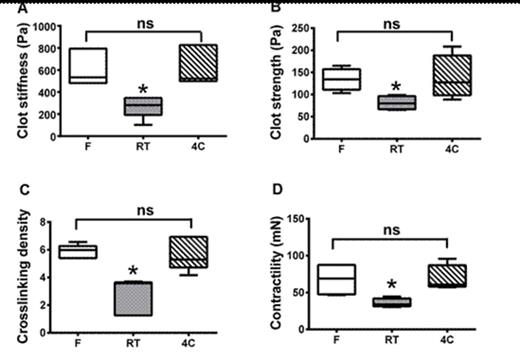Abstract
Background: Platelet transfusion is vital for hemostasis in patients with severe bleeding. Currently, platelets are stored at room temperature (RT) for 5 days with gentle agitation. However, this method results in a platelet storage lesion characterized by loss of platelet function and elevated risk of bacterial contamination. It has been shown that refrigeration of platelets at 4o C mitigates adverse effects and other logistical difficulties. Recently, FDA approved the use of cold-stored apheresis platelets for the resuscitation of actively bleeding patients for up to 3 days (5. 21 CFR 606.65(e) & 610.53(c)). We hypothesized that the refrigeration of platelets stored in 65% platelet additive solution (PAS), would better preserve the platelet contractile apparatus and overall hemostatic function. We measured clot stiffness, strength, crosslinking density and platelet contractile forces (PCF) using cone and plate rheometry; and quantified the microstructural architecture of the clots. To corroborate the rheological and morphological measurements with the clotting mechanism, we assayed thrombin generation, FXIII activity, clot retraction, and cytoskeletal rearrangement.
Methods: Apheresis platelet (AP) concentrates collected from 4 healthy donors were isolated and stored in 65% Platelet additive solution (PAS) for 5 days at RT (22-24°C) or 4C (4°C). Clotting function was assayed after re-suspension in fresh frozen plasma (FFP). After initiating clotting with 20mM Ca2+, 100µL of the PRP sample was placed on the rheometer plate and clot stiffness was measured for 30 mins at 37o C at a small strain of 1Hz by tracking the evolving storage modulus (G'). Normal force measurements were made to quantify the force generated in the samples as a result of platelet contractile forces. Subsequently, a progressively increasing strain of 1 to 250% was applied until the clot was irreversibly deformed to estimate the yield point (clot strength). Scanning Electron Microscopy was performed on the clots from the rheological analysis to study the clot microstructure. Thrombin generation and FXIII activity were determined using Calibrated Automated Thrombogram and activity assays, respectively. Further, the cytoskeletal rearrangement was studied by activating the washed platelets with thrombin/ TRAP for 5, 10 and 15 seconds and estimating the G-actin to F-actin turnover by Western Blots. The results were analyzed using one-way ANOVA and a post hoc Tukey test for multiple comparisons. The groups were considered statistically significant for p values less than 0.05.
Results: The rheological studies on clotting indicate that cold stored platelets form clots that have comparable properties to fresh platelets. RT-stored platelets formed weaker clots (Fig. 1A, B). These findings supported by the evidence of increased FXIII cross-linking activity (Fig.1C). Further, the normal force measurements indicate reduced force generation in RT-stored platelets which imply decreased platelet contractility (Fig. 1D). We also observed differences in geometry and orientation of individual fibrin fibers between fresh and stored platelets. Our preliminary results suggest that thrombin generation potential, crosslinking density, and platelet contractility may contribute to the mechanical strength and morphological differences between fresh and platelets stored at cold and room temperature.
Conclusion: Cold-stored platelets form structurally and mechanically stable clots compared to 5 day stored RT platelets as demonstrated by the rheological and microstructural studies. Together, these data suggest that 4C platelets are hemostatically more active than the current standard-of-care and may offer a better solution to patients for resuscitation of bleeding trauma patients.
Figure 1 Mechanical testing of evolving clot by rheometry. (A) RT-stored platelets form clots with decreased clot stiffness (G') compared to fresh (F) and cold-stored (4C) platelets (B) Clot strength was defined as the yield point where the clot deformed irreversibly. Clots formed from RT-stored platelets offer less resistance to strain; (C) Relative Cross Linking Density was estimated as the slope of stress-strain curve obtained from amplitude sweep. RT-stored platelet clots show less crosslinking; (D) less contractile force generation in RT platelets. * p <0.05, n=4.
No relevant conflicts of interest to declare.
Author notes
Asterisk with author names denotes non-ASH members.


This feature is available to Subscribers Only
Sign In or Create an Account Close Modal